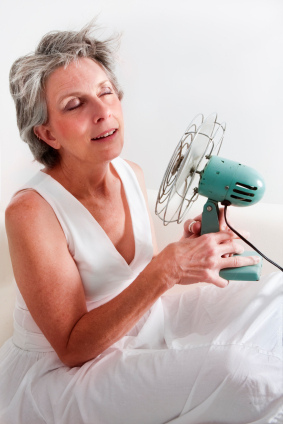One important idea in a holistic approach to health is that symptoms or uncomfortable physical experiences don’t exist separate and apart from the whole person. For this reason, it is important to know how a unique individual experiences that symptom or experience. Another important idea is that the whole person consists of a physical body, but also thoughts, feelings, even spirit, and she lives in a social and physical world that affects her. Holistic practitioners say “I am a body,” not “I have a body.”
What does this mean to a woman bothered by hot flashes? First, one good starting place for a woman is to look inside herself at her individual experience. Hot flashes are often said to be the bane of a woman’s existence, creating intense discomfort, mood swings, embarrassment. However, in reality women differ. Some women are greatly bothered by flashes. Others are not. Some say flashes are power surges. For some, the flash is purely a feeling of heat; for others, it feels more like anxiety. Very distressed women may have experiences like insomnia, depression, fatigue, fogginess. It turns out that the frequency of flashes is distinct from how distressing they are. For some women but not others simple remedies like dressing in layers works. In a scientific sense, we know more than we did not long ago, but there is still no fundamental understanding of what a hot flash is, or why some women but not others experience them.
Cultivating an inner observer can be useful to identify personal experience. Mindfulness is one approach to this. For many women, thoughts are an integral part of the hot flash experience, and these thoughts might contribute to how distressing flashes are. Expecting the worst might amplify distress, as it does for other experiences like pain. One example of an expectation is: “I’m going to have hot flashes for the rest of my life.” The meaning of flashes—natural, an indication of aging, a worrisome sign that something puzzling is going on in your body–might be important. Embarrassment and self-doubt in social settings are known to sometimes contribute to experiencing flashes as problems. Coping self-talk—for example, “this is a hot flash, it will pass” –might be helpful. Relaxing the body and observing a flash rather than tensing the body to resist it might make flashes less distressing. Paradoxically, distancing ourselves from bodily experience—for example, tensing the body until a flash passes, may be less effective than accepting bodily experience as our own with an attitude of observing it. Other active problem-solving might also be useful, like finding solutions to social problems. Women who talk with other women about flashes tend to find them less distressing.
Of course, other women just want to be rid of flashes. They might have very distressing, debilitating symptoms. They may simply just not want to put up with them. For some, focusing their attention on flashes might not make things better or even make things worse. Active problem-solving can work here, also. For example, flashes are often associated with triggers (stress, foods like chocolate, caffeine, etc.) that vary from woman to woman. Triggers, once identified, can be avoided. A woman can make time to take care of herself, doing something pleasurable or rejuvenating, find ways to reduce stress, or otherwise alter her lifestyle. A variety of remedies have been suggested, ranging from herbal remedies, to alternative practices and practitioners, to hormone therapies. Actively deciding that a hormone therapy is needed given her own situation might be a way a woman actively takes charge of her experience.
Hot flashes are not invaders. They are sometimes welcome, often not, but always one’s own bodily experience. Through gathering information, self-observation, talking with others, or finding helpful practices and practitioners, they can be dealt with.



This has just started for me, right now I can deal with it; not sure what I’ll do when it gets worse